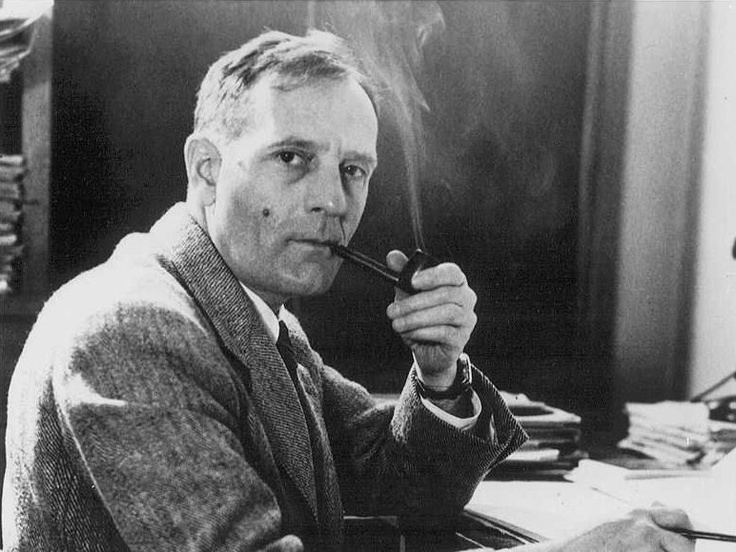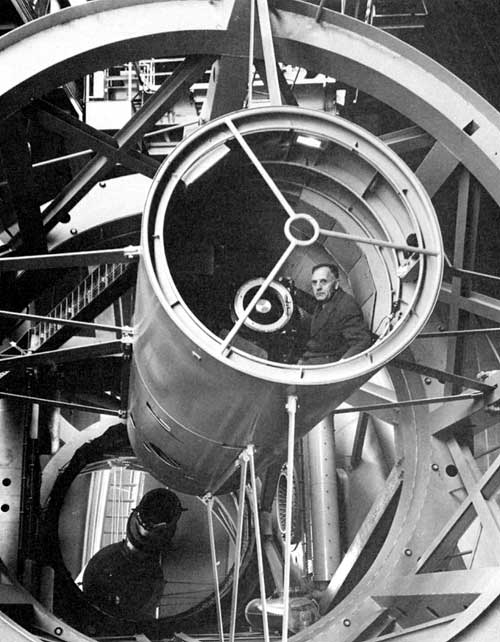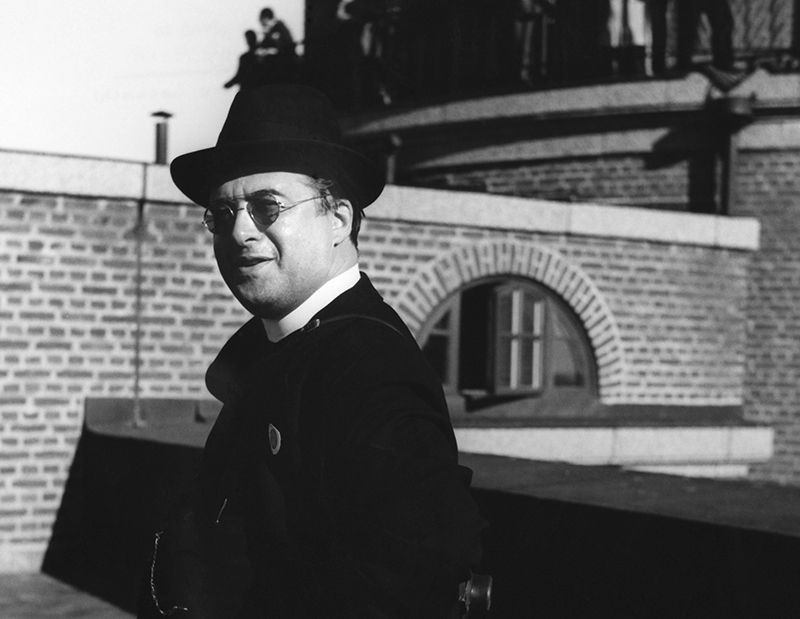
Who was Edwin Hubble?
Happy birthday, Edwin Hubble, born on November 20, 1889. The Hubble Space Telescope bears this astronomer’s name. His work helped define our modern cosmology: our idea of the universe as a whole.
Hubble was a multi-talented man who majored in science as an undergraduate at the University of Chicago. To keep a promise to his dying father, he studied law. He was also an amateur heavyweight boxer, and reportedly turned down the chance to fight professionally. As a graduate student, he returned to science at Yerkes Observatory in Wisconsin. In 1919, he accepted a position at the prestigious Mount Wilson Observatory in California, where he remained until his death in 1953. Shortly before his death, Hubble became the first astronomer to use the newly completed, famous Hale Telescope at the Palomar Observatory near San Diego, California. At the time, the 200-inch (5.1-meter) was among the largest in the world.
Hubble helped astronomers see that we live in an expanding universe, where every galaxy is moving away from every other. This discovery was known as Hubble’s law for many years. At its simplest, the law states that, the more distant the galaxy, the faster it is moving away from us. This is at the heart of our modern cosmology. The entire universe – space, time and matter – is thought to have been born in a Big Bang.
In 2018, the International Astronomical Union, or IAU, voted to rename Hubble’s law as the Hubble-Lemaître law. More about that change below.
The 2022 lunar calendars are here. Order yours before they’re gone!

Edwin Hubble’s special place in the history of astronomy
A hundred years ago, most astronomers believed our whole universe consisted of just one galaxy: our own Milky Way. In the 1920s, Hubble was among the first to recognize that there is a universe of galaxies beyond the boundaries of our Milky Way. What a truly mind-blowing realization!
Edwin Hubble observed stars in a hazy patch of light that at the time was known as the Andromeda nebula. Specifically, Hubble observed variable stars, those that change in brightness. He measured the period of how long a star took to dim and brighten. From the period of brightening, he calculated the star’s intrinsic brightness. From that, he could calculate the distance. That’s when he realized that the stars in this nebula were so far away that it couldn’t exist within our own galaxy.
At the time, many astronomers believed that the Andromeda nebula was a forming solar system, within the Milky Way’s boundaries. Hubble showed that this patch of light was really a separate galaxy. Thanks to Hubble, we know it today as the Andromeda galaxy. It is the nearest large spiral galaxy beyond the Milky Way.
A galaxy in Andromeda
The Andromeda galaxy is about 2.5 million light-years beyond our Milky Way. We also know that other galaxies extend around us in space for many billions of light-years. To people in the 1920s, though, this was a revelation. As soon as astronomers learned that spiral nebulae like the one in Andromeda are separate galaxies, the known universe got much bigger.

Enter the expanding universe
But was this huge universe stationary? Or was it expanding? Or contracting?
The answer involved the light of galaxies as a whole. Astronomers observed shifts toward the red end of the spectrum in distant galaxies’ light. They interpreted this red shift as a sign that the galaxies are moving away from us. Hubble and his colleagues compared the distance estimates to other galaxies’ with their red shifts. On March 15, 1929 – Hubble published his observation that the farthest galaxies are moving away faster than the closest ones.
This is the insight that initially became known as Hubble’s law.
Albert Einstein was supposedly elated to hear of Hubble’s work. Einstein’s Theory of Relativity implied that the universe must either be expanding or contracting. Einstein himself, however, had rejected this notion. Instead, he had favored the accepted idea that the universe was stationary and had always existed.
When Hubble presented his evidence of the expansion of the universe, Einstein embraced the idea. He called his adherence to the old idea his “greatest blunder.”

Renaming Edwin Hubble’s law as the Hubble-Lemaître law
In late October 2018, members of the International Astronomical Union (IAU) voted to change the name of the Hubble law as Hubble-Lemaître law. This change gives credit to the Belgian priest and astronomer Georges Lemaître. Of the 4,060 voting astronomers (of around 11,072 eligible members), 78 percent favored of this change.
In the 1920s, some two years before Hubble, Georges Lemaître described how the expansion of the universe causes galaxies to move away from Earth at speeds proportional to their distance. Lemaître was a Belgian Catholic priest, mathematician, astronomer, and professor of physics at the Catholic University of Louvain. Before Hubble did, he described the relationship between a galaxy’s recessional speed and its distance.
Among professional astronomers and science history students, Lemaître’s name has long been known and honored for his achievement. Writing in Nature on October 30, 2018, Elizabeth Gibney said of the IAU’s acknowledgement of Lemaître:
The move seems to be the first time an organization has voted to alter the name of a scientific law – although some scientists doubt whether the change will be noticed. The IAU has been the arbiter of planet and moon names since 1919, and oversees astronomers’ official catalogue of star names, but it has no formal mandate over the names of scientific laws.
Piero Benvenuti is a former IAU general secretary who proposed the name change. He told Nature that the new terminology is a recommendation only, saying:
If people will continue to use the Hubble law naming, nobody will object.
We will see if astronomers and their students will slowly shift into using the name Hubble-Lemaître law, instead of Hubble law. A Google search in November 2018, shortly after the IAU vote, found 119,000 results for the name. A search today does not return many results for “Hubble-Lemaître law.”
Read more from Nature: Belgian priest recognized in Hubble-law name change

Bottom line: Edwin Hubble’s birthday is November 20, 1889. Hubble showed there are separate galaxies beyond our Milky Way and the more distant the galaxy, the faster it moves away from us. The Hubble Space Telescope bears his name.
Deepest view we have yet, into our universe: the Hubble eXtreme Deep Field
The post Edwin Hubble and the expanding universe first appeared on EarthSky.
from EarthSky https://ift.tt/32dIgLf

Who was Edwin Hubble?
Happy birthday, Edwin Hubble, born on November 20, 1889. The Hubble Space Telescope bears this astronomer’s name. His work helped define our modern cosmology: our idea of the universe as a whole.
Hubble was a multi-talented man who majored in science as an undergraduate at the University of Chicago. To keep a promise to his dying father, he studied law. He was also an amateur heavyweight boxer, and reportedly turned down the chance to fight professionally. As a graduate student, he returned to science at Yerkes Observatory in Wisconsin. In 1919, he accepted a position at the prestigious Mount Wilson Observatory in California, where he remained until his death in 1953. Shortly before his death, Hubble became the first astronomer to use the newly completed, famous Hale Telescope at the Palomar Observatory near San Diego, California. At the time, the 200-inch (5.1-meter) was among the largest in the world.
Hubble helped astronomers see that we live in an expanding universe, where every galaxy is moving away from every other. This discovery was known as Hubble’s law for many years. At its simplest, the law states that, the more distant the galaxy, the faster it is moving away from us. This is at the heart of our modern cosmology. The entire universe – space, time and matter – is thought to have been born in a Big Bang.
In 2018, the International Astronomical Union, or IAU, voted to rename Hubble’s law as the Hubble-Lemaître law. More about that change below.
The 2022 lunar calendars are here. Order yours before they’re gone!

Edwin Hubble’s special place in the history of astronomy
A hundred years ago, most astronomers believed our whole universe consisted of just one galaxy: our own Milky Way. In the 1920s, Hubble was among the first to recognize that there is a universe of galaxies beyond the boundaries of our Milky Way. What a truly mind-blowing realization!
Edwin Hubble observed stars in a hazy patch of light that at the time was known as the Andromeda nebula. Specifically, Hubble observed variable stars, those that change in brightness. He measured the period of how long a star took to dim and brighten. From the period of brightening, he calculated the star’s intrinsic brightness. From that, he could calculate the distance. That’s when he realized that the stars in this nebula were so far away that it couldn’t exist within our own galaxy.
At the time, many astronomers believed that the Andromeda nebula was a forming solar system, within the Milky Way’s boundaries. Hubble showed that this patch of light was really a separate galaxy. Thanks to Hubble, we know it today as the Andromeda galaxy. It is the nearest large spiral galaxy beyond the Milky Way.
A galaxy in Andromeda
The Andromeda galaxy is about 2.5 million light-years beyond our Milky Way. We also know that other galaxies extend around us in space for many billions of light-years. To people in the 1920s, though, this was a revelation. As soon as astronomers learned that spiral nebulae like the one in Andromeda are separate galaxies, the known universe got much bigger.

Enter the expanding universe
But was this huge universe stationary? Or was it expanding? Or contracting?
The answer involved the light of galaxies as a whole. Astronomers observed shifts toward the red end of the spectrum in distant galaxies’ light. They interpreted this red shift as a sign that the galaxies are moving away from us. Hubble and his colleagues compared the distance estimates to other galaxies’ with their red shifts. On March 15, 1929 – Hubble published his observation that the farthest galaxies are moving away faster than the closest ones.
This is the insight that initially became known as Hubble’s law.
Albert Einstein was supposedly elated to hear of Hubble’s work. Einstein’s Theory of Relativity implied that the universe must either be expanding or contracting. Einstein himself, however, had rejected this notion. Instead, he had favored the accepted idea that the universe was stationary and had always existed.
When Hubble presented his evidence of the expansion of the universe, Einstein embraced the idea. He called his adherence to the old idea his “greatest blunder.”

Renaming Edwin Hubble’s law as the Hubble-Lemaître law
In late October 2018, members of the International Astronomical Union (IAU) voted to change the name of the Hubble law as Hubble-Lemaître law. This change gives credit to the Belgian priest and astronomer Georges Lemaître. Of the 4,060 voting astronomers (of around 11,072 eligible members), 78 percent favored of this change.
In the 1920s, some two years before Hubble, Georges Lemaître described how the expansion of the universe causes galaxies to move away from Earth at speeds proportional to their distance. Lemaître was a Belgian Catholic priest, mathematician, astronomer, and professor of physics at the Catholic University of Louvain. Before Hubble did, he described the relationship between a galaxy’s recessional speed and its distance.
Among professional astronomers and science history students, Lemaître’s name has long been known and honored for his achievement. Writing in Nature on October 30, 2018, Elizabeth Gibney said of the IAU’s acknowledgement of Lemaître:
The move seems to be the first time an organization has voted to alter the name of a scientific law – although some scientists doubt whether the change will be noticed. The IAU has been the arbiter of planet and moon names since 1919, and oversees astronomers’ official catalogue of star names, but it has no formal mandate over the names of scientific laws.
Piero Benvenuti is a former IAU general secretary who proposed the name change. He told Nature that the new terminology is a recommendation only, saying:
If people will continue to use the Hubble law naming, nobody will object.
We will see if astronomers and their students will slowly shift into using the name Hubble-Lemaître law, instead of Hubble law. A Google search in November 2018, shortly after the IAU vote, found 119,000 results for the name. A search today does not return many results for “Hubble-Lemaître law.”
Read more from Nature: Belgian priest recognized in Hubble-law name change

Bottom line: Edwin Hubble’s birthday is November 20, 1889. Hubble showed there are separate galaxies beyond our Milky Way and the more distant the galaxy, the faster it moves away from us. The Hubble Space Telescope bears his name.
Deepest view we have yet, into our universe: the Hubble eXtreme Deep Field
The post Edwin Hubble and the expanding universe first appeared on EarthSky.
from EarthSky https://ift.tt/32dIgLf

Aucun commentaire:
Enregistrer un commentaire